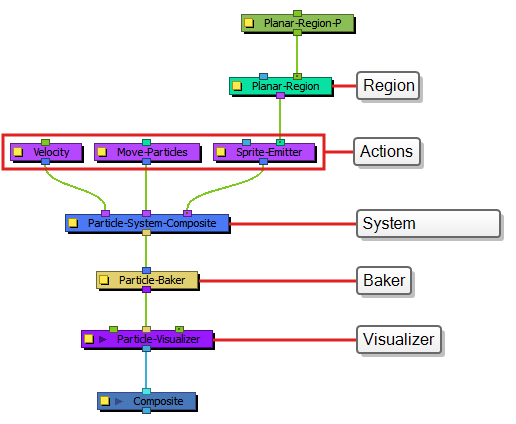This is what the basic structure of a particle system looks like in the Node view. This structure can change depending on the type of effect you are trying to create.

Colour Coding
Particle effects are colour coded to make them easy to identify by colour and function. Each colour represents a different function. For example, Action nodes, such as Velocity, Move-Particles and the Sprite Emitter are purple.
You’ll also notice that the ports above and below each node are colour-coded. These indicate the kind of node these ports should be connected to. For example, the output (bottom) port of an Action node is dark blue, which is the colour of the Particle-System-Composite node, to which Action nodes must be connected.
Otherwise, some particle nodes have standard green and blue ports, which must be connected to standard peg and image ports respectively. This can help you easily structure your particle system as you add components to it.
Node Types
The types of nodes that are part of a particle system are as follows:
- Region: These nodes are used to define the region from where the particles are emitted. These regions can be Planar or 3D.
- Region Composite: This node combines Region nodes. In case you have more than one region in your effect, this composite will help define the position and the render order of the different regions.
- Action: These nodes define the particle dynamics. They determine how particles are created and moved around in space. If there are multiple Action nodes hooked to a composite, they are executed from right to left. Hence, it is typical of a particle system to have an Emitter node in its right-most port, as this node creates the particles before they are affected by other actions.
- System Composite: Unlike a regular composite that reads all the position information from its in-port nodes and combines them accordingly, a System Composite is specifically designed to handle Action node information.
- Baker: These nodes allow you to make decisions about the way the particles are created and processed.
- Visualizer: This node assembles a particle system through its middle port and renders it as a flat image that can be composited onto your scene. It also allows you to offset and animate the generated image. The left input port allows you to connect it to a peg that will offset, scale and rotate the rendered image. The right input port allows you to connect it to a peg that will determine the position of the rendered image on the z-axis, without affecting its apparent size.